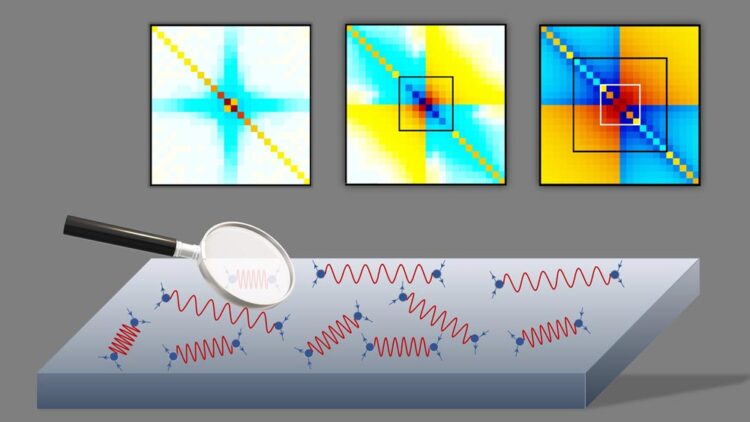CSI Solid-State: The fingerprints of quantum effects

Die drei farbigen Tafeln veranschaulichen die Streuprozesse. Die schwarzen und weißen Quadrate markieren die wichtigen charakteristischen Strukturen, die in der PRL-Arbeit identifiziert und beschrieben wurden.
Bildnachweis: Patrick Chalupa
In solid-state physics, the precise interactions of electrons are analyzed through meticulous detective work, ultimately to gain a better understanding of fundamental physical phenomena.
It comes as no surprise to fans of the thriller genre that in order to solve a case, fingerprints must be carefully located at the crime scene. In modern-day solid-state physics, scientists look for scattering processes—interactions between electrons—that hold the clues necessary for getting closer to the truth.
Revealing these crucial hints is particularly difficult in the case of complex materials, where many electrons play a role simultaneously. In so-called “many-electron systems,” trillions of electrons can be connected to one another and exchange energy and momentum. At the Vienna University of Technology, the University of Tübingen and the École Polytechnique in Paris, researchers have made important progress: With the help of a precise analysis, new structures were identified—characteristic patterns in the complicated scattering processes that can help to “clear the case.”
Scattering processes and material properties
Among other properties, scattering processes determine the mobility of the charge carriers and thus control whether the system ultimately exhibits a metallic, insulating or even superconducting behavior. Simply put, these mathematical quantities reflect how strong the electrons interact. With the help of extensive computer simulations, condensed matter researchers attempt to nail down the physical properties of many-electron systems, and ultimately answer fundamental questions of solid-state physics, for example: “How do unconventional superconductors work?” or “How do quantum physical phase transitions take place at absolute zero?”
An international research team, including the group of Professor Alessandro Toschi (Patrick Chalupa, Matthias Reitner und Daniel Springer) from the TU Wien, Professor Sabine Andergassen from the University of Tübingen and Thomas Schäfer from the École Polytechnique in Paris, has achieved important progress in this respect. An in-depth analysis of the scattering processes and their comparison in different physical situations allowed for the identification of clear-cut “fingerprints.” The results of the study were published in the journal Physical Review Letters.
New connections uncovered
Similar to forensic scientists at a crime scene, the researchers tried to connect many small details to see the bigger picture. They succeeded in identifying characteristic structures in the complex mathematical quantities that describe the scattering processes and to relate these structures to two fundamental phenomena of solid-state physics. These fundamental phenomena turned out to be the formation of local magnetic moments as well as their screening due to the so-called Kondo effect, which both crucially control the mobility of electrons. This new connection allows for recognizing the relevant physical effects in the complex scattering processes in just a single glance. By identifying these “fingerprints,” it was even possible to discover an alternative criterion for determining one of the most fundamental energy scales in theoretical solid-state physics: the Kondo temperature.
Eventually, these findings could shed new light on previously unsolved mysteries in solid-state physics, for example, quantum criticality in heavy fermion systems, unconventional superconductivity in strongly correlated quantum materials and surprising magnetic phenomena in transition metal oxides. The correct determination of the underlying quantum fingerprints could put research on the right track to understand these systems at a fundamental level.
Explore further
More information: P. Chalupa et al. Fingerprints of the Local Moment Formation and its Kondo Screening in the Generalized Susceptibilities of Many-Electron Problems, Physical Review Letters (2021). DOI: 10.1103/PhysRevLett.126.056403
Media Contact
All latest news from the category: Physics and Astronomy
This area deals with the fundamental laws and building blocks of nature and how they interact, the properties and the behavior of matter, and research into space and time and their structures.
innovations-report provides in-depth reports and articles on subjects such as astrophysics, laser technologies, nuclear, quantum, particle and solid-state physics, nanotechnologies, planetary research and findings (Mars, Venus) and developments related to the Hubble Telescope.
Newest articles

Innovative 3D printed scaffolds offer new hope for bone healing
Researchers at the Institute for Bioengineering of Catalonia have developed novel 3D printed PLA-CaP scaffolds that promote blood vessel formation, ensuring better healing and regeneration of bone tissue. Bone is…

The surprising role of gut infection in Alzheimer’s disease
ASU- and Banner Alzheimer’s Institute-led study implicates link between a common virus and the disease, which travels from the gut to the brain and may be a target for antiviral…

Molecular gardening: New enzymes discovered for protein modification pruning
How deubiquitinases USP53 and USP54 cleave long polyubiquitin chains and how the former is linked to liver disease in children. Deubiquitinases (DUBs) are enzymes used by cells to trim protein…


